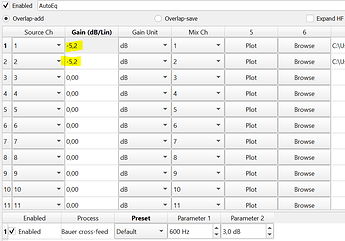Are you convolving any room correction Sean ? I have seen criticism of mp filters (in general, not HQP specifically) as creating phase issues with the bass. I haven’t heard a difference, but I’m not sure what it would sound like. It might be more noticeable if room correction went astray.
I am, I am time-aligning all drivers individually (including subs), DSP crossover, room EQ.
But pretty much all my thoughts in this thread (changing my mind on which is the ‘best’ filter every couple of weeks it seems  ) are related to headphones use.
) are related to headphones use.
I don’t change much with speakers. Differences with digital filters are much smaller for me with speakers than headphones.
Although I would probably fail blind testing for all my uses.
Both sides are right in their own way, but take things to either extreme based on their point of view. Depending on person and material one may prefer things one way or the other.
To me, the most interesting challenge is to achieve good results from both points of view simultaneously. This is challenging because they are mathematically related in inversely proportional way. With some careful math tuning, one can get closer to the impossible. My first take on middle-ground topic are poly-sinc-short and poly-sinc filters. And then later xtr, ext2 and long took this more towards the longer side, while the “mqa” took it towards the shorter side. These are still between the most extremes, trying to reach sort of balance and achieve the impossible.
Analog filters are generally minimum phase. And most room correction filters too, because otherwise you easily start hearing the pre-ringing with linear-phase filters. So usually room correction filters are at least mixed phase or similar to reduce pre-ringing that has frequency in the middle of audio band.
A few weeks ago I was really thinking poly-sinc-long-mp gave me the ‘best of both worlds’ (on headphones). No pre-ringing and extended FR. And I assume over 120dB stop-band attenuation like other poly-sinc filters.
I’ll go back to that soon to see if I still think that.
Received my new MacMini with M1 8core today and use it as dedicated machine for HQP Desktop. I have to say: the MacMini is not very impressed by upsampling to DSD256 with poly-sinc-short-mp and ADSM7!
Good job Jussi! Sound difference to DSD128 on my former old MacMini is fantastic.
In other words, sinc-L is a long but not steep filter? That’s interesting. Any chance for a Sinc-L MP?
You have the horsepower to use the ADSM7EC modulator. It is MUCH better than ADSM7.
Thanks for the hint, I’ll check!
The minimal phase filter array available in HQP does keep me awake, thats one sure thing  But it rattles and screams all over the place, so it is a bit to enthusiastic, so to say. I need the calm well balanced top, but when the drummer phrases one beat it must respond. With poly-sinc-ext2 the magic of both sides are there. Very good sound stage, and when “needed” it steps up a punch me in the face, but not all the time, as I can feel with mp-filters. ext2 is a very well tuned filter with to my ears very good balance. Especially the sibilence in hard core metal that almost cut your ear off is so very well in control and I can play loud enough to the scare the neighbours, without actually feeling it is too loud. Dangerous stuff, for the hearing health.
But it rattles and screams all over the place, so it is a bit to enthusiastic, so to say. I need the calm well balanced top, but when the drummer phrases one beat it must respond. With poly-sinc-ext2 the magic of both sides are there. Very good sound stage, and when “needed” it steps up a punch me in the face, but not all the time, as I can feel with mp-filters. ext2 is a very well tuned filter with to my ears very good balance. Especially the sibilence in hard core metal that almost cut your ear off is so very well in control and I can play loud enough to the scare the neighbours, without actually feeling it is too loud. Dangerous stuff, for the hearing health.
For me I am still using Sinc L, plays back beautifully on everything. I guess the type of DAC used also plays a part?
Sinc L doesn’t seem to get much love but seems to work very well on an R2R DAC…well mine anyway
It’s also interesting to read that short filters have better transients. See this is the information I was not aware of. I think there there needs to be a sticky somewhere explaining what everything means and brings to the table.
I read the help notes but they don’t really go into depth of what long, short, mp, please etc mean. Yep I need an idiots guide lol.I’m not that technical but I know what sound I like 
The problem with a sticky is that opinions differ. As @dabassgoesboomboom was pointing out, at least one well respected designer thinks long filters do better with transients.
That’s just filter length. The transients debate also crosses over to PCM vs DSD .
Same designer argues that the PCM does better with transients - his DAC FPGA upsamples to 5-bit SDM at approx 104MHz sample rate… compared with 1-bit SDM at approx 11MHz/22MHz (DSD256/DSD512 upsampling that we do with HQPlayer).
The more I learn the more my head starts spinning ![]()
1st world problems at it’s best of course.
Or 50 MHz if you do DSD1024… HQPlayer also supports DSD2048 which would reach 100 MHz, if someone would have hardware for it.
But the rate or number of SDM bits doesn’t matter so much beyond ~10 MHz rate. DSD256 is already enough to give you flat noise floor beyond 100 kHz audio bandwidth. DSD512 increases this to 200 kHz and DSD1024 to 400 kHz. Since the widest bandwidth recording microphones do 100 kHz, DSD256 is enough for those purposes.
Modulator design itself matters more than the rate or number of bits it produces. Same goes largely for filters too, for example you can have many different kinds of million tap filters and filter topologies. Like for example 120 dB attenuation vs 240 dB attenuation (a million times difference).
Also said designer’s long filter operates only up to 705.6/768k rate and then a very much simplified filter is used up from there. While HQPlayer can run complex filters to the MHz output rates. Like sinc-L is 16 million taps for DSD256 output and operates to the 11 MHz rate.
OTOH, if you use non-apodizing upsampling filter and the ADC/production side decimation anti-alias filter (which you will need for PCM) spoiled the transients, spoiled transients you are also going to get from the DAC output. Only with apodizing filter you can get those transients fixed. So don’t assume that the source data is good unspoiled stuff, usually it is not.
There are so many aspects to the topic, not just transients or any other single thing.
I sort of get that but a sticky of what every element is supposed to do. A description of what Short brings to the table and the thinking behind it for example. Basically a Key/description of everything that can be referred to. Even basic stuff like transients etc
It would be nice to know what I am hearing and why.I might have something that has a wide soundstage but could sound a bit too harsh. I would love to be able to look at the filter and refer to the key. This should explain as to why I am hearing what I am hearing. At the moment I dont really why
No, you disable convolution engine. Download the AutoEq parametric eq .txt file and load it to the corresponding matrix pipeline and enable matrix engine. That’s pretty much all needed!
You can also create a profile for it, so you can even switch the corrections on fly.
this is the parametric eq on github
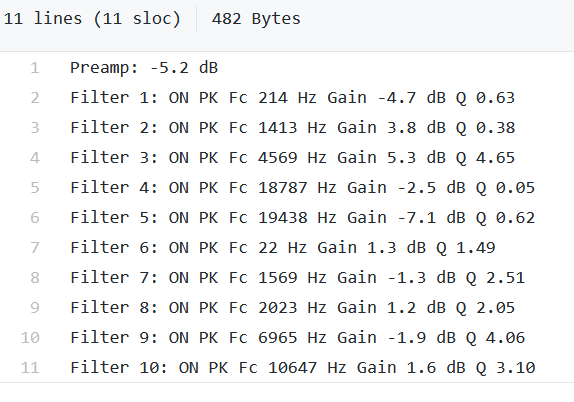
i cant download that so i made my own. (without preamp is that right?)
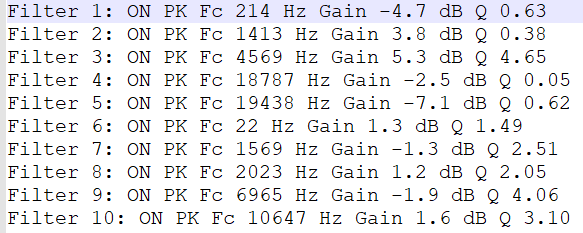
should i use two channels here for stereo headset? is expandHF any “better”?
the first three here are txt. is parametric the “best”
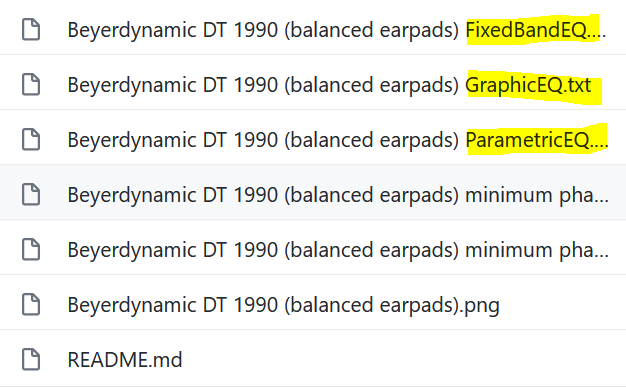
can i put this to 0 if i already set db down with eq?
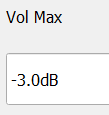
thank you very much
You can download it is easily, select “Raw” from upper right corner, then right-click on the browser and select “Save As” or similar. You should get the file as-is in text format.
No, with the Preamp-line. It is important (unless you manually specify it).
Yes, excatly. You don’t need those gain figures if you keep the “Preamp” line. Without it, you should enter the gain compensation values as you have done. Either way is fine with same result.
“ParametricEQ” is the one to use. It is very flexible and very low overhead to process too.
No, the compensation just brings the levels back to “what it used to be”. -3 dBFS volume setting is needed to leave headroom for inter-sample overs. These are two different things.
This -3 dBFS setting is important, but I don’t want to hide it. I rather want that things that are being done are transparent. Roon has similar goals with in this respect with it’s “signal path” display.
sorry for beeing offtopic again…
but now i have set -5.2 db with autoeq and -3db hqplayer settings. i drive that headphones only with the evga nu card. loudness is to low.
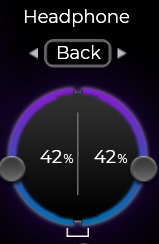
42% would meet the 250 ohm headphone. want do you think, how high i can go here?

